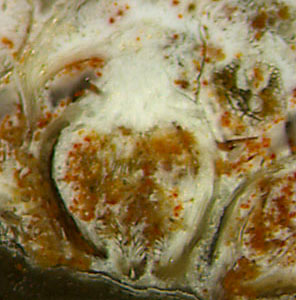Maggot fern confusion
After the small silicified pinnules from the big fronds of some tree
fern, found before 1800 in the Permian Döhlen basin near Dresden, had
been thought to be woodlice or maggots, their vegetable nature was
recognised, and they got the name
Scolecopteris elegans [1], which
means Delicate Maggot Fern. This essentially ended the confusion, but
not completely as meanwhile
more then two dozen maggot fern species have been described worldwide
[2]. Concerning the Döhlen basin, information was contradictory.
Disregarding obvious structural differences, all finds were ascribed to
the same species [3,4] but with the caution that "... nevertheless the
suspicion of the existence of additional ferns must always be kept up"
[3] p.74. This advice had been obsolete even then because there was no
doubt about the existence of other ferns. Pinnules with synangia borne
on thick long pedicels as in [5], Fig.8, had been there in [6] but had
not been noticed.
One maggot fern sample
from Döhlen basin,
offered as a typical specimen
of Sc.
elegans [4], has been recognised, after careful
inspection, as another species, as shown in the contribution Maggot
Fern Dispute. The present contribution provides
additional evidence.



Figs.1-3:
"Maggot Fern"
synangia with big pedicels:
not Sc. elegans,
possibly Sturiella intermedia
[2].
Picture heights:
1.5mm, 2mm.
The
synangia pedicels, which
are rather long compared to the very short pedicels
of Sc. elegans
[5],
are distinctly visible here. Obviously only very few of the randomly
positioned and oriented synangia show their pedicels well on the cut
face. In Fig.3, for example, the synangium on the right has been cut
such that no pedicel is seen.
Apart from the big pedicels as evidence for a different species, a few
additional details are given here.

Fig.4: Synangia on the surface of the same sample as in Fig.1-3. Picture
height 2mm.
The cross-sections of the synangia on the raw surface (Fig.4) show
that here, like with Sc. elegans,
the number of sporangia and the symmetry of their arrangement are no
characteristic features. (This has been known since the early work
by E. Zenker
[1] but vain talk about symmetry
had entered into the maggot fern literature nevertheless.)
With knowledge about the related pedicels
lacking, a line
drawing of the synangia in Fig.4 had been offered as Sc.
elegans in 2002
[7], 2011 [5], 2018 [8]. In this sample the big pedicels
were noticed by careful investigation as late as 2019. Apparently the
synangia and everything else in this sample must be ascribed to another
species now, contrary to the claim by M. Barthel
that everything "can doubtless be ascribed to
Scolecopteris elegans" [4]. That
claim has proved not justified. Hence, the 8 pictures in
[4], p.227, may serve as illustrations of another fern,
probably Sturiella intermedia
[2], also known as Scolecopteris intermedia
[9], which,
apart from the pedicels, is rather similar to Sc. elegans and
therefore might keep the popular name "maggot fern".
Possibly more of the fossil fern pinnules from the type locality
thought to represent the classical maggot fern have to be reconsidered.
Sample: Bu8/18, found by
Ulrich
Wagner (Dresden) at the type locality of Sc. elegans in
1997.
H.-J. Weiss
2019
[1] E.
Zenker:
Scolecopteris elegans,
ein neues fossiles Farrngewächs mit
Fructification. Linnaea 11(1837), 509-12.
[2] M.A. Millay:
A review of permineralized Euramerican Carboniferous tree
ferns. Rev. Palaeobot. Palyn. 95(1997), 191-209.
[3] M. Barthel:
Die Madensteine vom Windberg. in: U. Dernbach, W.D. Tidwell:
Geheimnisse versteinerter Pflanzen. D'ORO 2002. S.65-77.
[4] M. Barthel: Die
Rotliegendflora der Döhlen-Formation. Geologica Saxonica 61 (2) 2015
(2016 erschienen), 105-238. S.226
[5] H.-J. Weiss:
Scolecopteris
synangium stalks – real and illusory.
www.chertnews.de, Permian Chert News 4.
[6] M. Barthel:
Pecopteris-Arten E.F. v. Schlotheims aus Typuslokalitäten in der DDR,
Schriftenreihe geol. Wiss. Berlin 16(1980), 275-304.
[7] H.-J.
Weiss: Beobachtungen zur Variabilität der Synangien des
Madenfarns. Veröff. Museum f. Naturkunde Chemnitz 25(2002), 57-62.
[8] H.-J.
Weiss: Sächsische
Madensteine - ein reiches Forschungsfeld, nicht gut bestellt. www.chertnews.de,
Permian
Chert News 19.
[9] A. Lesnikowska,
J. Galtier: A reconsideration of four genera of
permineralized Marattiales ... Rev. Pal. Pal. 67(1991), 141-152.
|
 |
 26 26 |

 26
26




 26
26